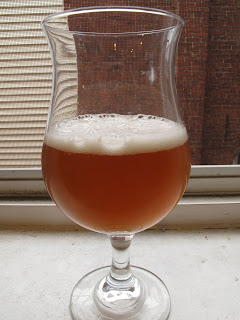Well, it's come time to do some modifications in my brewing procedure. When I first started, I was using a 30qt enamel canning pot to do full boils on an electric stove in my first apartment. I had such a hard time getting to a boil that I needed to keep the lid on partially for the bulk of boiling. Since then, I've upgraded to a (borrowed) aluminum 32qt pot and turkey fryer, a 25' immersion chiller and then a 50' copper chiller (using the former as a pre-chiller). When I left Kansas I gave my good buddy my larger chiller as I didn't think I'd be brewing much in the near future. Since I started brewing again here in DC, I've just been using my 25' chiller attached to the kitchen faucet. Again, since I moved from my previous apartment to here in Columbia Heights, I don't have a faucet that's adaptable to my chilling setup, and had to use an aquarium pump to pump chilled water through my chiller.
(Extra) long story short, I've been really dissatisfied with my chilling setup, as it takes nearly 45min to an hour to reach appropriate pitching temps (seasons aside). Jamil's
whirlpool chiller has been something I've loved to upgrade to, but it requires a heavy duty pump that is well over $100. Since then, I've tried to find other ways to bypass this most important brewing process. The "no-chill" method whereby the brewer stores his near boiling wort in an HDPE container (or other heat tolerant container) overnight, or when they're ready to pitch yeast, seems to be getting very popular. There are several reasons for going this route: no water is used, and perhaps wasted, during the chilling process. The brewer saves some time by no chilling and pitching yeast the next day. There's less exposure to air and environment during chilling when the wort is at its most able to be infected by wild yeast/bacteria.
However, there have been many (unproven at least) detractors to this method. One is a combination of excess DMS production and potential chill haze by factors of covering the wort while it's still at boiling temps and not creating a well defined (and separated) cold break. According to many
brewers, these are simply mysteries, and proven untrue. The most disturbing possibility is that of
botulism which can thrive under a rich sugar environment with the absence of oxygen. However, many brewers think that the density of sugar and the lowered pH of wort is enough to thwart the possibilty of infection. In addition, by shortening the process from "chilling" to pitching yeast to <48hrs, it's possible to make this infection nonexistant.
I've since been sold to trying this process as the investment is limited to purchasing sealed HDPE containers which at a
maximum are $15 a piece. These can also be used as fermenters with an appropriate stopper, but are extremely oxygen permeable (415 times a wooden barrel, 13 times a glass carboy with silicone stopper) so they shouldn't be used for prolonged storage.
Well, throughout the arguments I've heard, I'm compelled to give this a shot. I've yet to ascertain a time period in which massive amounts of DMS can be tasted/smelled, and will be doing 90min boils from now in with Pilsner malt rich malt bills. If anyone has any tips to add to my process, I'm more than happy to learn.



